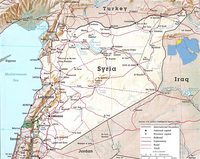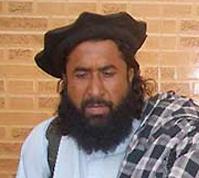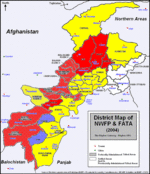The US has struck again inside Pakistan's lawless tribal areas. The latest airstrike targeted a key al Qaeda facilitator who served as a bridge between the Taliban and al Qaeda. The US is also stating that al Qaeda operative Khalid Habib was killed in last week's strike in South Waziristan.
Today's strike in the town of Mir Ali killed an estimated 15 to 20 people, according to reports. Pakistani intelligence sources claim al Qaeda operative Abu Kasha was killed in the attack. The reports have not been confirmed.
Kasha was an Iraqi national who operated in the Mir Ali region. In January 2007, an American military intelligence official told The Long War Journal that Abu Kasha was the key link between al Qaeda's Shura Majlis -- main Shura or consultive body -- and the Taliban.
His resonsibilities have expanded to assisting in facilitating al Qaeda external operations against the West, a senior US military intelligence official told told The Long War Journal today.
Kasha commanded two local Pakistani commanders, Imanullah and Haq Nawaz Dawar. These men administer al Qaeda's network in Mir Ali. Kasha had a working relationship and close communication with the Uzbek terror groups, including the Islamic Jihad Group run by Najimuddin Uzbek, who also operates out of North Waziristan.
US intelligence believes Khalid Habib was killed in last week's strikes
Last week's airstrike in North Waziristan has netted a senior al Qaeda leader, according to US intelligence sources. A senior US military intelligence official told The Long War Journal that Khalid's death was "very likely." Sources were skeptical of the early reports of Habib's death.
Yesterday, Los Angeles Times reported that intelligence officials said Khalid was believed dead. Today, sources told ABC News that "the US now has evidence that Khalid Habib was killed."
Habib served as the commander of al Qaeda's paramilitary forces in Pakistan's tribal areas. This responsibility would placed him in charge of al Qaeda's notorious 055 Brigade and the other Arab and foreign brigades that have formed in Pakistan’s tribal areas.
Habib also assisted in al Qaeda's external operations aimed at the US and Europe. "US officials have detected advanced efforts in the Waziristan area by Habib and others to send terror teams to the US and Europe," ABC News reported. "A number of suspected European and American recruits have been spotted in the area, officials have reported."
At least two Western members of al Qaeda have been killed in the recent spate of attacks. Two men carrying Canadian passports were killed in a US strike on al Qaeda safe house strike in South Waziristan on Aug. 30.
Habib has been described as "one of the five or six most capable, most experienced terrorists in the world." But he is not al Qaeda's "fourth-ranking person in the Qaeda hierarchy," a senior US military intelligence official told The Long War Journal.
"The numbering of al Qaeda leaders beyond Osama bin Laden and Ayman al Zawahiri is wrong," the source said. The numbering of al Qaeda leaders "was done at a time when we didn't understand the group," the source said, explaining that senior leaders share responsibilities and the network is not hierarchical in nature.
Attacking al Qaeda's external operations
The US campaign in Pakistan is aimed at disrupting al Qaeda's ability to attack the West, US intelligence officials told The Long War Journal on Sept. 19. US intelligence believes the next attack launched against the West will originate from Pakistan's tribal areas, where al Qaeda operates 157 known training camps.
There have been 26 recorded cross-border attacks and attempts in Pakistan in 2008, according to numbers compiled by The Long War Journal. Nineteen of these attacks have occurred since Aug. 31. There were only 10 strikes during 2006 and 2007 combined.
Four senior al Qaeda leaders -- Abu Laith al Libi, Abu Sulayman Jazairi, Abu Khabab al Masri, and Khalid Habib -- have been killed during the strikes in Pakistan’s tribal areas in 2008.
The first major strike against al Qaeda's external operations network took place in the town of Damadola in the Bajaur tribal agency on May 14. The missile strike killed Abu Sulayman Jazairi, a senior Algerian al Qaeda operatives who western intelligence sources described as the operational commander tasked with planning attacks on the West. Fourteen others were killed in the strike, including several members of Jazairi's staff.
Jazairi succeeded Abu Ubaidah al Masri, a senior al Qaeda operative who served as al Qaeda operations chief for global strikes. Ubaidah is thought to have died of an illness. In addition to being al Qaeda's external operations chief, Jazairi also was a senior trainer and an explosives expert. These skills enabled him to directly train operatives for strikes in the West.
The next major strike occurred more than two months later in the Azam Warsak region in South Waziristan on July 28. The attack killed Midhat Mursi al Sayyid Umar, a senior al Qaeda commander who is better known as Abu Khabab al Masri, along with four members of his staff.
Khabab served as the chief of al Qaeda's weapons of mass destruction program, known as Project al Zabadi. He is best known for running a training camp at Derunta in Afghanistan, where he conducted experiments on animals to determine the effectiveness of chemical weapons. Khabab was also a master bomb-marker, and passed his skills onto his associates.
Other airstrikes have targeted Taliban and al Qaeda safe houses in the tribal areas run by Baitullah Mehsud, Jalaluddin Haqqani, and Mullah Nazir. All three Taliban leaders provide shelter to al Qaeda and sponsor terror camps in their tribal areas.
Jalaluddin and his son, Siraj, have close links with al Qaeda and are actively recruiting and training foreign al Qaeda members to conduct attacks in Afghanistan and the West.
Qari Hussain, who is Pakistani Taliban commander Baitullah Mehsud’s deputy, runs a suicide training camp for children in South Waziristan.
US attacks inside Pakistan and incidents along the border in 2008:
• US strikes kills al Qaeda operative in North Waziristan
Oct. 31, 2008
• US targets Taliban "facility" in South Waziristan
Oct. 26, 2008
• US hits Haqqani Network in North Waziristan
Oct. 22, 2008
• US strike in Baitullah Mehsud's territory kills 6
Oct. 16, 2008
• US targets safe house in North Waziristan
Oct. 11, 2008
• US strike kills 9 al Qaeda and Taliban in North Waziristan
Oct. 9, 2008
• US conducts two strikes in North Waziristan
Oct. 3, 2008
• Taliban: Baitullah Mehsud alive; US strike in North Waziristan
Oct. 1, 2008
• Pakistan military fires on ISAF forces
Sept. 25, 2008
• Pakistani military fires on US helicopters at border
Sept. 22, 2008
• US strikes Taliban camp in South Waziristan
Sept. 17, 2008
• Report: US helicopters fired on while crossing Pakistani border
Sept. 15, 2008
• US hits compound in North Waziristan,
Sept. 12, 2008
• US targets Haqqani Network in North Waziristan,
Sept. 8, 2008
• US airstrike killed five al Qaeda operatives in North Waziristan,
Sept. 5, 2008
• Report: US airstrike kills four in North Waziristan,
Sept. 4, 2008
• Pakistanis claim US helicopter-borne forces assaulted village in South Waziristan,
Sept. 3, 2008
• US hits al Qaeda safe house in North Waziristan,
Aug. 31, 2008
• Five killed in al Qaeda safe house strike in South Waziristan,
Aug. 31, 2008
• Al Qaeda safe house targeted in South Waziristan strike,
Aug. 20, 2008
• Cross-border strike targets one of the Taliban's 157 training camps in Pakistan's northwest,
Aug. 13, 2008
• Six killed in strike in South Waziristan,
July 28, 2008
• Report: Strike targets Baitullah Mehsud's hideout in Pakistan,
June 14, 2008
• Senior Algerian al Qaeda operative killed in May 14 strike inside Pakistan,
May 24, 2008
• Missile strike kills 20 in South Waziristan,
March 16, 2008
• Unprecedented Coalition strike nails the Haqqani Network in North Waziristan,
March 13, 2008
• Missile strike on al Qaeda meeting in South Waziristan kills 13,
Feb. 28, 2008
• Senior al Qaeda leader Abu Laith al Libi killed in North Waziristan,
Jan. 31, 2008





 BAJAUR AGENCY: There is a report of the killing of an important leader of a banned outfit Tehreek-i-Taliban as a result of the ongoing security forces’ operation in Bajaur Agency, FATA on Saturday.
BAJAUR AGENCY: There is a report of the killing of an important leader of a banned outfit Tehreek-i-Taliban as a result of the ongoing security forces’ operation in Bajaur Agency, FATA on Saturday.



